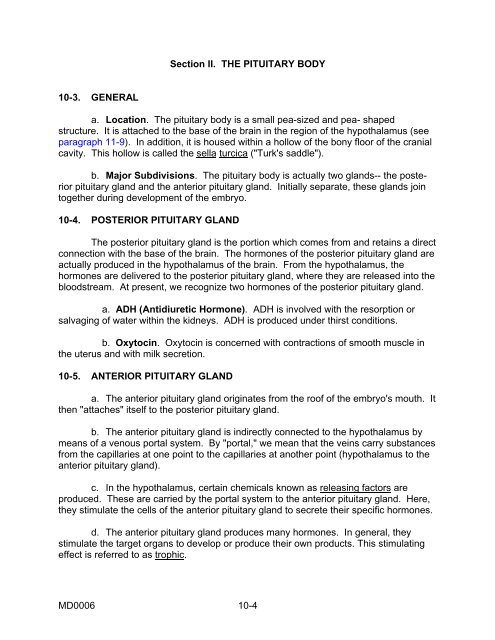md0006 - BASIC HUMAN ANATOMY.pdf - Raems.com
md0006 - BASIC HUMAN ANATOMY.pdf - Raems.com
md0006 - BASIC HUMAN ANATOMY.pdf - Raems.com
Create successful ePaper yourself
Turn your PDF publications into a flip-book with our unique Google optimized e-Paper software.
10-3. GENERAL<br />
Section II. THE PITUITARY BODY<br />
a. Location. The pituitary body is a small pea-sized and pea- shaped<br />
structure. It is attached to the base of the brain in the region of the hypothalamus (see<br />
paragraph 11-9). In addition, it is housed within a hollow of the bony floor of the cranial<br />
cavity. This hollow is called the sella turcica ("Turk's saddle").<br />
b. Major Subdivisions. The pituitary body is actually two glands-- the posterior<br />
pituitary gland and the anterior pituitary gland. Initially separate, these glands join<br />
together during development of the embryo.<br />
10-4. POSTERIOR PITUITARY GLAND<br />
The posterior pituitary gland is the portion which <strong>com</strong>es from and retains a direct<br />
connection with the base of the brain. The hormones of the posterior pituitary gland are<br />
actually produced in the hypothalamus of the brain. From the hypothalamus, the<br />
hormones are delivered to the posterior pituitary gland, where they are released into the<br />
bloodstream. At present, we recognize two hormones of the posterior pituitary gland.<br />
a. ADH (Antidiuretic Hormone). ADH is involved with the resorption or<br />
salvaging of water within the kidneys. ADH is produced under thirst conditions.<br />
b. Oxytocin. Oxytocin is concerned with contractions of smooth muscle in<br />
the uterus and with milk secretion.<br />
10-5. ANTERIOR PITUITARY GLAND<br />
a. The anterior pituitary gland originates from the roof of the embryo's mouth. It<br />
then "attaches" itself to the posterior pituitary gland.<br />
b. The anterior pituitary gland is indirectly connected to the hypothalamus by<br />
means of a venous portal system. By "portal," we mean that the veins carry substances<br />
from the capillaries at one point to the capillaries at another point (hypothalamus to the<br />
anterior pituitary gland).<br />
c. In the hypothalamus, certain chemicals known as releasing factors are<br />
produced. These are carried by the portal system to the anterior pituitary gland. Here,<br />
they stimulate the cells of the anterior pituitary gland to secrete their specific hormones.<br />
d. The anterior pituitary gland produces many hormones. In general, they<br />
stimulate the target organs to develop or produce their own products. This stimulating<br />
effect is referred to as trophic.<br />
MD0006 10-4
















